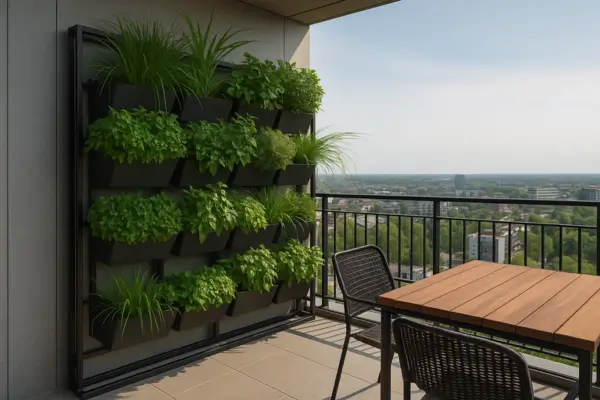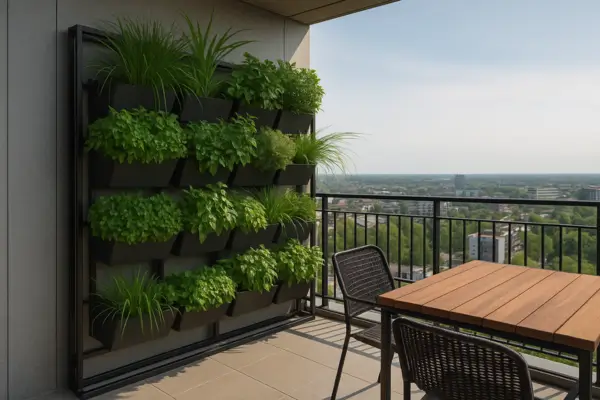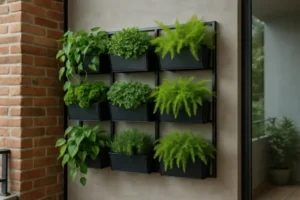If you live in a high-rise apartment, a wind-blocking vertical garden might be the smartest way to reclaim your balcony from harsh gusts. Whether you’re trying to enjoy a quiet dinner or protect your plants, wind can turn a beautiful space into a frustrating one.
This kind of vertical garden offers more than just shelter — it creates a calming green wall that softens airflow and brings life to your balcony. The result is a space that feels like an extension of your home, not just a windy ledge.
In this guide, we’ll show you how to use vertical gardens to manage wind without giving up light, airflow, or style. Let’s turn that breezy balcony into a cozy, functional retreat.
Wind-Blocking Vertical Garden: Why It Works on High-Rise Balconies
Using plants as a natural wind buffer isn’t just practical — it’s surprisingly effective, especially on high-rise balconies where wind can feel constant and overpowering.
A vertical garden acts like a breathable shield. Instead of completely stopping the airflow, it diffuses it, softening gusts and redirecting the breeze more gently across the space.
This is what makes vertical gardens different from glass panels, metal screens, or solid walls. While those options block wind abruptly — often creating uncomfortable air pressure pockets — plants absorb and break the wind gradually. The result is a calmer, more balanced space that feels open, yet protected.
Vertical gardens are ideal for gourmet balconies, where the space needs to be functional and beautiful at the same time. Whether you’re grilling, enjoying a meal, or simply relaxing, a green wall brings both comfort and atmosphere without making the space feel boxed in.

Here’s what a well-designed wind-blocking vertical garden can offer:
- Gentle airflow instead of harsh gusts, improving the comfort of dining or cooking
- Filtered light and partial shade, without darkening the space
- A visual softening of hard balcony edges, making the area feel more natural
- Noise buffering, especially useful in urban settings with traffic or nearby buildings
- A warm, green backdrop that visually connects the indoor and outdoor areas
Ultimately, your vertical garden becomes more than a wind solution — it becomes an organic extension of your living space, inviting you to use the balcony more often and more fully.
Understanding Wind Behavior on Balconies
Before choosing plants or placing your vertical garden, it’s essential to understand how wind behaves on your specific balcony. Wind doesn’t move in straight lines — it curves, funnels, bounces, and swirls depending on the layout of the building, nearby structures, and even the time of year.
On high-rise balconies, the wind often feels stronger because there are fewer obstacles to slow it down. It tends to funnel around corners and accelerate in narrow gaps, creating sudden gusts or unpredictable turbulence.
Even the position of railings, neighboring balconies, or nearby buildings can change how the air flows through your space.
To plan your wind-blocking vertical garden effectively, take time to observe or measure these key factors:
- Wind direction: Use a compass app or simple paper test to identify the main path the wind takes
- Wind consistency: Is it present year-round or mostly seasonal (e.g., during spring or late afternoons)?
- Surrounding materials: Hard glass, tile, or concrete walls reflect wind and heat differently than open or soft materials
- Balcony orientation: North, south, east, or west — each direction affects wind exposure and sun angle
- Open vs. enclosed corners: Exposed corners tend to amplify gusts, while side walls may offer partial protection
Mapping this out helps you place your vertical garden with intention. Instead of just filling a wall for decoration, you’ll be creating a natural wind buffer exactly where it’s needed — improving comfort, protecting plants, and making your balcony a more enjoyable place to be.
Choosing the Best Plants for Wind Buffering
Not all plants handle wind the same way — and in vertical gardens, the wrong choice can lead to drooping stems, broken leaves, or poor growth. That’s why selecting the right species is essential when building a wind-blocking vertical garden.
The goal isn’t to stop the wind completely, but to break its force gently, creating movement and softness without letting harsh gusts dominate your balcony. For that, you’ll need plants that are resilient, flexible, and dense enough to filter the airflow.
What to Look for in Wind-Resistant Plants
When selecting species, focus on plants with these qualities:
- Strong stems that bend without snapping
- Compact or layered foliage to interrupt wind without forming a solid wall
- Low water loss — wind can dry plants quickly, so drought-tolerant varieties are ideal
- Adaptability to vertical or hanging growth, depending on your modular setup
Choosing a mix of textures, heights, and densities also improves airflow while keeping the space visually interesting.
Recommended Plants for Wind-Exposed Vertical Gardens
Here are some of the best plant types to consider for balconies exposed to steady or occasional wind:
- Bamboo (clumping varieties) – Tall, elegant, and flexible. Avoid running types, which spread aggressively.
- Boxwood – Dense and compact, ideal for shaping and forming low wind barriers in modular rows.
- Thyme, rosemary, lavender – Tough, aromatic, and edible — perfect for gourmet balconies with a culinary touch.
- Ivy or pothos – Trailing plants that add vertical softness while still letting air pass through.
- Ornamental grasses – Like fountain grass or miscanthus. These sway beautifully and recover quickly after strong breezes.
Strategic Placement for Maximum Effect
Think of your garden like a layered curtain. Use bushier, more rigid plants on the outer edge, especially where wind hits hardest. Place trailing or lighter plants closer to the center or lower sections of the wall to soften the flow and add depth.
This not only protects your plants — it helps you control the air movement across your gourmet balcony, creating a calm, usable, and visually rich environment.
Modular Systems That Withstand Wind
A strong vertical garden needs more than just resilient plants — it needs a solid structure that can stand up to constant pressure, especially in high-rise balconies. Wind affects not only the greenery, but also the frames, fasteners, and overall stability of your system.
If your modular garden isn’t built for outdoor use, it may shift, detach, or warp over time — which compromises both safety and plant health. That’s why choosing the right system is essential for long-term success.
Key Features of Wind-Resistant Modular Systems
When selecting a vertical garden system for windy balconies, prioritize these structural features:
- Sturdy metal or composite frames: They hold shape under pressure and don’t crack or bend easily like plastic
- Outdoor-grade mounting hardware: Anchors and brackets should be rated for vertical, external use and resistant to rust
- Adjustable, stackable modules: Allow for better height control and plant density depending on wind exposure
- Weight balance design: Systems with heavier base panels or integrated planters add extra grounding without extra fixtures
These elements work together to reduce movement and prevent tension on screws or anchors — especially important in locations exposed to strong crosswinds.
What to Avoid in High-Wind Conditions
While many modular garden systems promise quick setup and flexibility, not all are suitable for high-rise balconies exposed to strong or unpredictable wind. Some materials and designs may work well in sheltered areas — but fail quickly when exposed to daily gusts.
Before choosing a system, be cautious with options that prioritize portability or aesthetics over structure. In the long term, a weak frame or poor mounting system will compromise both your plants and your space’s safety.
Here are a few things to avoid when building a wind-resistant vertical garden:
- Lightweight plastic panels – While inexpensive, they can flex, warp, or even detach in strong wind. Many aren’t UV-resistant and degrade faster under sun and stress.
- Unsecured freestanding racks – Unless properly anchored or supported, these can shift, tilt, or fall, especially on narrow balconies or during storms.
- Systems with exposed backing or hollow frames – Wind can get trapped behind the structure, creating pressure pockets that pull on screws and strain the wall surface.
These risks aren’t just about aesthetics — they can cause real structural issues, especially when the garden is placed near dining zones, grills, or decorative furniture.
Choosing a system designed to handle wind may require more planning and a slightly higher investment, but the payoff is clear: greater durability, fewer repairs, and a balcony that stays safe, usable, and beautiful — even when the breeze picks up. In a gourmet space, that kind of reliability is part of the comfort you’re creating.
Strategic Placement: Blocking Wind Without Losing Light
A well-placed vertical garden does more than look good — it changes how your balcony feels and functions. When designed to block wind, its positioning becomes just as important as the plants or structure itself. The challenge is to create shelter without turning your gourmet balcony into a dark, closed-off space.
In windy high-rise settings, the wrong placement can lead to air pressure buildup, reduced sunlight, and poor air circulation. The right placement, on the other hand, lets you enjoy a calm, airy space that still feels open and bright.
Start with the Windward Side
The windward side is the direction from which the wind most frequently blows. Installing your vertical garden here helps reduce the strongest gusts before they reach your seating or cooking areas. Use a compass or simply observe the wind patterns at different times of day.
Create a Layered Effect
Rather than forming a solid green wall, aim to break the wind gradually. This approach avoids sudden shifts in airflow and keeps the space breathable. You can do this by applying:
- Partial gaps between modules to let air filter through naturally
- Tiered heights, placing taller plants or structures at the edges and shorter ones toward the center
- Alternating plant densities, using denser foliage where needed but mixing in trailing or open varieties for visual and airflow balance
- Glass railings or mesh screens behind or around your garden to reinforce the barrier without losing light
Use Angles to Your Advantage
If your balcony shape allows, angle the vertical garden slightly rather than placing it flat against the wall. This can help deflect wind sideways, minimizing direct impact while preserving cross-ventilation and sunlight.
By placing your vertical garden strategically — and thinking in layers rather than barriers — you transform it into a tool that controls the environment, not just decorates it. The result is a gourmet balcony that feels more protected, more usable, and still beautifully open to the outdoors.
Design Tips to Keep It Beautiful and Functional
A vertical garden that blocks wind doesn’t need to sacrifice charm. Especially on a gourmet balcony — where you might enjoy weekend brunches, casual wine nights, or simply unwind after work — style plays a big role in how welcoming the space feels.
Form and function can go hand in hand. With just a few thoughtful design choices, your wind-buffering setup can also serve as a natural focal point for the entire outdoor area.
Blend Beauty with Practicality
Start by choosing plants and modules that are both resilient and visually appealing. Texture, color, and layout matter when the garden is part of a shared, stylish space.
Here are a few ideas to guide your layout:
- Mix leaf textures — Combine smooth, waxy leaves with feathery or spiky ones to create depth
- Alternate foliage and herbs — Add flowering herbs like basil, oregano, or chives for pops of color and scent
- Use neutral or earthy planters — Clay, wood, or matte black finishes pair well with most balcony furniture
- Install warm, indirect lighting — Spotlights or LED strips near aromatic plants enhance ambiance at night
- Repeat plant groupings — Use visual rhythm by placing the same trio of plants every few rows or modules
These subtle design patterns turn your vertical garden into a cohesive part of the balcony’s decor — not just a utility structure against the wind.
Create Zones Within Your Garden
Another design trick is to segment the vertical garden visually. Use taller plants on one side, culinary herbs in the center, and softer trailing greens near seating areas. This adds personality and helps define different uses within a small space — like a quiet reading corner or a mini herb bar next to the grill.
When aesthetics are treated with the same care as structure, your wind-blocking vertical garden becomes more than just functional. It becomes a curated part of your home — a space to enjoy, not just escape the breeze.
Maintaining a Wind-Blocking Vertical Garden
Even the most beautiful vertical garden needs care — and when it’s exposed to wind, a few extra precautions help keep everything stable, safe, and thriving. Fortunately, maintenance doesn’t have to be complicated. It just needs to be consistent.
Wind affects moisture levels, structure tension, and how quickly debris builds up. That means your garden will benefit from a slightly different routine than one placed in a sheltered courtyard or indoor wall.
Smart Maintenance Tips for Windy Balconies
Here’s what to focus on to keep your garden looking great and functioning well:
- Inspect mounting hardware monthly — Look for rust, wobbling, or loose screws, especially after storms
- Prune regularly — Control overgrowth to maintain airflow and reduce wind resistance
- Secure irrigation lines — Use clips or ties to prevent hoses from swinging and damaging stems
- Use slow-release fertilizer — Wind tends to dry soil faster, so a gradual nutrient release keeps plants fed
- Clean behind the modules — Wind can push leaves, dust, and debris behind the structure, which may trap moisture or attract pests
Seasonal Check-Ins Matter
At the change of each season, take 10–15 minutes to check your entire system — from structure to soil. This is a great time to:
- Replace tired or wind-battered plants
- Re-tighten screws and relevel frames
- Refresh soil or add mulch to retain moisture
- Adjust irrigation schedules based on temperature and sun exposure
A little routine care can prolong the life of your system and the health of your plants, making sure your wind-blocking garden continues to protect and beautify your gourmet balcony all year round.
Frequently Asked Questions (FAQ)
If you’re thinking about installing a wind-blocking vertical garden on your balcony, it’s natural to have a few concerns — especially when dealing with strong gusts, limited space, or edible plants. Below are the most common questions people ask before getting started.
Can vertical gardens really reduce wind on a balcony?
Yes — and surprisingly well. While they won’t block wind entirely, vertical gardens work by disrupting airflow, softening gusts and reducing turbulence. When positioned on the windward side, they act like a breathable barrier, making your balcony much more comfortable.
Will wind damage the plants over time?
Not if you choose wisely. Look for resilient, flexible plants that can bend without breaking — like ornamental grasses, woody herbs, and certain vines. Combine that with regular pruning and good spacing, and your garden will adapt beautifully to wind exposure.
Is it safe to have a vertical garden on a high-rise balcony?
Yes, as long as it’s built properly. Safety comes from using a sturdy modular system, securely anchored to walls rated for outdoor use. Avoid lightweight plastic units or unstable racks in windy environments — especially above the 5th floor.
Can I use edible plants in a wind-blocking setup?
Absolutely. In fact, many culinary herbs are perfect for windy balconies — rosemary, thyme, mint, and chives are all hardy and add flavor to your meals. Bonus: their fragrance enhances the ambiance of your gourmet space.
What’s better: dense or open planting?
The best results come from a balanced mix. Dense sections help block the wind, while open areas allow for light and airflow. This also gives your garden a more natural, layered look — both practical and visually appealing.
Conclusion
A wind-blocking vertical garden can turn a windy balcony from a challenge into one of your favorite spots at home. With the right design, it becomes more than just a solution — it adds texture, greenery, and a calming rhythm to your outdoor space.
You don’t need to give up sunlight, airflow, or beauty. With smart placement, sturdy structure, and plants that love the breeze, your garden transforms harsh gusts into gentle air movement that feels refreshing, not disruptive.
In the end, your gourmet balcony becomes more than just a view. It becomes a comfortable retreat, a lush escape, and a space to enjoy life — whether you’re cooking, relaxing, or entertaining, even thirty floors above the street.




